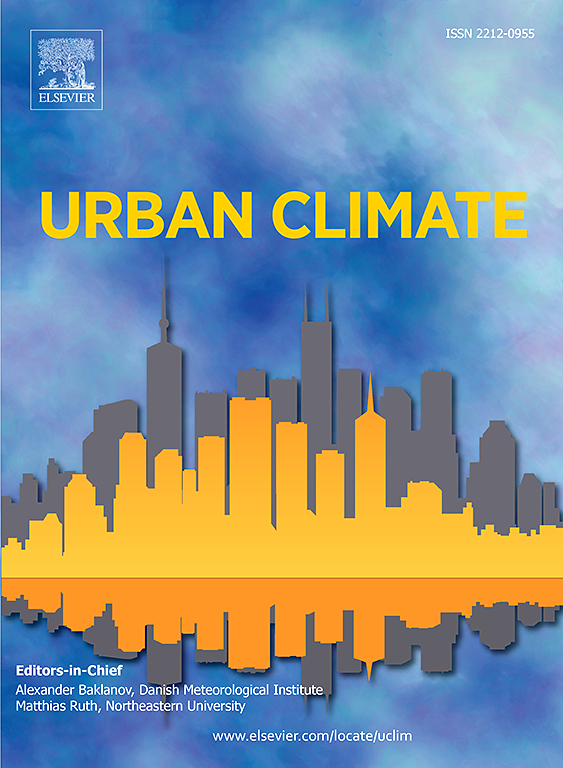Evaluating the effectiveness of tree canopy and building shade in urban heat mitigation using solar radiation transmittance
IF 6
2区 工程技术
Q1 ENVIRONMENTAL SCIENCES
引用次数: 0
Abstract
Urban Heat Island (UHI) effects challenge pedestrian thermal comfort and urban livability, particularly in high-density cities. This study employs Solar Radiation Transmittance (SRT) mapping and Physiologically Equivalent Temperature (PET) analysis to quantify urban shading benefits, with in-situ measurements in Tainan and Taipei, Taiwan. A GIS-based approach standardizes tree shade and building shadow effects on solar radiation, identifying shade-deficient areas.
Results indicate that tree shade provides stable cooling effects, while building shadow significantly reduces solar radiation but may exacerbate UHI. Field measurements show SRT values ranging from 0.18 to 0.60 for tree shade and 0.02 to 0.25 for building shadow, with a strong negative correlation between Leaf Area Index (LAI) and SRT (R2 = 0.95). Increased shading reduced PET by 1–2 °C, enhancing thermal comfort and walkability.
This study introduces the concept of micro-scale and urban grid-scale SRT. In Taiwan, common tree species exhibit SRT values of 0.2–0.5 (mean = 0.3), while building shadow SRT ranges from 0.02 to 0.18 (mean = 0.14). Using SRT = 0.3, ArcGIS solar radiation simulations corrected sub-canopy radiation, and grid-based SRTj assessed baseline urban radiation conditions.
Findings provide a spatially explicit approach for urban planners to prioritize shading improvements in high-exposure areas, contributing to sustainable heat adaptation strategies.
利用太阳辐射透过率评价树冠和建筑遮阳在城市减热中的效果
城市热岛效应挑战了行人热舒适性和城市宜居性,特别是在高密度城市。本研究利用太阳辐射透过率(SRT)图和生理等效温度(PET)分析,在台湾台南和台北进行城市遮阳效益量化研究。一种基于gis的方法标准化了树荫和建筑阴影对太阳辐射的影响,确定了缺乏树荫的地区。结果表明,遮荫提供稳定的降温效果,而建筑阴影显著减少太阳辐射,但可能加剧热岛热岛。实测结果显示,林荫SRT值为0.18 ~ 0.60,建筑荫SRT值为0.02 ~ 0.25,叶面积指数(LAI)与SRT呈显著负相关(R2 = 0.95)。增加遮阳降低PET 1-2°C,提高热舒适性和步行性。本文介绍了微尺度和城市网格尺度SRT的概念。台湾常见树种的SRT值为0.2 ~ 0.5(平均0.3),而建筑荫的SRT值为0.02 ~ 0.18(平均0.14)。使用SRT = 0.3, ArcGIS太阳辐射模拟修正了冠层下辐射,基于网格的SRTj评估了基线城市辐射状况。研究结果为城市规划者提供了空间明确的方法,以优先考虑高暴露区域的遮阳改善,有助于可持续的热适应策略。
本文章由计算机程序翻译,如有差异,请以英文原文为准。
求助全文
约1分钟内获得全文
求助全文
来源期刊

Urban Climate
Social Sciences-Urban Studies
CiteScore
9.70
自引率
9.40%
发文量
286
期刊介绍:
Urban Climate serves the scientific and decision making communities with the publication of research on theory, science and applications relevant to understanding urban climatic conditions and change in relation to their geography and to demographic, socioeconomic, institutional, technological and environmental dynamics and global change. Targeted towards both disciplinary and interdisciplinary audiences, this journal publishes original research papers, comprehensive review articles, book reviews, and short communications on topics including, but not limited to, the following:
Urban meteorology and climate[...]
Urban environmental pollution[...]
Adaptation to global change[...]
Urban economic and social issues[...]
Research Approaches[...]
 求助内容:
求助内容: 应助结果提醒方式:
应助结果提醒方式:


